Bad Education
The sadly always topical abuse scandals of the Catholic Church rear their head thirty years earlier in Pedro Almodóvar's Bad Education. One boy, Ignacio, is subjected to the sexual abuse, another, Enrique, ironically punished and expelled for his mild homosexual attraction to his abused friend. Ten years later the two boys have shot off in completely different trajectories both psychologically and geographically. The crossed-lovers finally meet again when the abused boy, grown up into a bedraggled but handsome young man and struggling actor (Gael García Bernal) approaches his brief boyhood soul-mate Enrique (Fele Martínez) who is now a movie director.
The paths that landed the two men in their respective positions are markedly different. Enrique, stunted by his unfulfilled childhood experience, is artistically inspired by the true-life bizarreness of wild tabloid tales. Ignacio's past is more mysterious and grows more convoluted as Bad Education submerges itself in a densely layered tapestry. Though Ignacio first contacts Enrique for a job what he also reveals is a short story that is supposedly half based on his and Enrique's childhood experiences-tales of abuse and love alike-mixed with a fictional half taking place later in Ignacio's life. Both these storylines are brought to life by Almodóvar, the former being a sweet, sad, and simple tale which must be quite common for the Catholic school setting. While this section, featuring an interesting and eventually dangerously sympathetic character in the form of the principal abuser Father Manolo, is generating controversial press, it really is the later section of Ignacio's story that convolutes Almodóvar's movie. In this tale, whose fictionality is highly questionable, Gael García Bernal reveals himself in drag, performing "Quizas, Quizas, Quizas" and seducing a drunk and unknowing young man in order to rob him, but the man turns out to be Enrique. Destitute, drug using, and rather desperate, Ignacio and his fellow transvestite Paca (Javier Cámara) decide to steal from the Church and blackmail Father Manolo. This story, titled "The Visits," hits the perfect note with Enrique, who is finally able to find a story of the outrageous-but-strangely-plausible variety, but one that strikes an uncanny personal note. The two men's relations become complicated when Ignacio insists on playing the "fictional" version of himself in the film, and Enrique finds there something different about his old friend, and something questionable about his story.
Almodóvar's film is highly complicated one, not in a way that is hard to follow but in a way that makes an unraveling of its endless parade of honest emotions, shrowded identities and motives, performed fictions, false realties and twisty-turny media (film, story, memory) a convoluted and unsatisfying affair. The elements of Bad Education are inherently fascinating, and with a lively score by Alberto Iglesias in the vein of Bernard Herrmann, the playful references to the cinema in general and film noir in specific, and the infectious glee of watching Bernal in effective drag, Almodóvar mixes a confounding amount of wild fun inside a story that masks its darkness in nearly impenetrable layers of thematic twists and turns. Those familiar with Almodóvar's auteur characteristics may find themselves more comfortable with Bad Education's web of characters who are gay, who are playing gay, who are gay and are playing gay, and those are investigating the nature of this whole convolution in general. In is in the film's occasional and amusing references to the generic plots of noirs-shady identity, amnesia, subjective memory, dangerous and fatalistic sexuality-where Almodovar almost achieves moments that not only resonate thematically but are also delightfully and intelligently stylized. But the moments are rare in the plot's haste in piling on and complicating the senario to the point of extreme disinterest.
The Joy(lessness) of Sex
Well, I just got back from a screening of Bruno Dumont’s Twentynine Palms (Steve, I now get what you mean about this film), and it got me thinking about some ideas that have been kicking around in my head since I saw Young Adam last weekend. Is it just me, or do the directors of NC-17 film (and for those who opt out of the bankrupt MPAA rating system, the unrated equivalents) which prominently feature graphic sex seek to punish the viewer for actually watching graphic depiction of sexuality? I’m no prude, and I’m all for honest and realistic expressions of sexuality (hell, I don’t even have a problem with most pornography), but the continuing trend in contemporary “art-porn” is just getting depressing, and this is coming from someone who likes many of these films ( Crash, Eyes Wide Shut, The Piano Teacher, Trouble Every Day and Fat Girl all come to mind).
Well, I guess that’s the point, since sex in these films is an example of exploitation; a calculated provocation against censorship; a signifier of alienation, either from oneself, others, or the outside world; and/or the site of a power struggle between men and women (most of them are all four), instead of something as common place as “just sex”. This even applies to films where the characters actually seem to enjoy the sexual acts they are participating in, such as The Dreamers, In the Realm of the Senses and Twentynine Palms. In the first film and second film, the characters are so self-involved with their little sex games, they are oblivious to the historical events going on around them, whereas in the latter film there’s something off about the depiction of the sexual/romantic relationship ( Phyrephox’s review does a good job of describing the way the image and performance serve to alienate the characters), for instance, there is little difference between the “climatic” sound design of the fucking, sodomy, or killing. The more I think about , the more I think I’m seeing the aftereffects of high modernism’s distrust of both the body, and more importantly, pleasure (which was regarded as politically reactionary).
In many ways, this art-house depiction of sexuality has become a complete counter cliché to the normal Hollywood depiction of sexuality with its ridiculously perfect bodies, soft lighting, elaborate choreography, cheesy musical scoring, and adherence to the puritanism of the MPAA. Most of the arthouse examples (despite the fact that in many instances, these films actually star attractive people) seek to do exactly the opposite, which is fine to a point, just like the Hollywood equivalent.
But I’m forced to ask, where is the full range of human experience? Or to put it another way, why can’t fucking be fun? Can’t sex by sexy or erotic without looking like a fashion shoot or music video? I’ve actually struggled to come up with films that fit into what I would regard as a more complex middle ground. Off the top of my head, I was able to come up with Vendredi soir, Late Marriage, Secretary, Sex and Lucia, American Pie (in a more comedic vein), and Unfaithful (which I think is the one film that is closest to the Hollywood mode of depiction, but Copy’s response to the film convinced me to include it here). In these films, sex can be awkward, painful, and full of negative consequences, but its also fun, funny, sexy, and pleasurable. To me, that’s real, and often more interesting.
Well, enough of my soapbox. What do you think?
 War Begins at Home: Bergman's Shame
War Begins at Home: Bergman's Shame
Ingmar Bergman's Shame is a film about the way war destroys not just bodies but souls, and it has all the forceful clarity of a true masterpiece. As is often the case with Bergman's classic films, there's not a single wasted shot in Shame, and it goes from tentative domestic peace to full-scale end-of-the-world destruction and despair in the course of a little over an hour and a half.
It's a story told very much in tune with the beat of ordinary life, and the way that life suddenly and dramatically changes when bombs start dropping. It's a story filled with long moments and dizzingly short ones, and it is told, more than anything, with faces. Bergman is great with faces; his close-ups pull all the truth out of a scene, due not just to Sven Nykvist's ace cinematography but the intensity of the performances of Liv Ullmann and Max von Sydow. The story is advanced through faces, through reactions, both close-ups and those extraordinary long takes of his; in particular, one over-the-shoulder conversation that -- just like a real conversation -- covers an extraordinary amount of emotional ground.
This is, of course, pure Bergman. One of the most intense shots in cinema history is Bibi Andersson's monologue in Winter Light, where she speaks directly into the camera for eight minutes, interrupted only by a single brief cut; you can't take your eyes off her because everything she says is vital. And who can ever forget Ingrid Thulin's lengthy sexual memory in Persona -- so intense that Pauline Kael said she knew of people who swear they remember it as being dramatized. (Kubrick aimed for the same effect with Nicole Kidman in Eyes Wide Shut.)
Shame begins in very typical Bergman fashion: a static shot of the bedroom of a married couple, Jan (von Sydow) and Eva (Ullmann) Rosenberg; it is morning, and an alarm clock goes off for an uncomfortably long time, enough to set you a little bit on edge -- like those car horns in Godard's Weekend. Eva is up and at `em, Jan lingers a bit, fingering a toothache, and over the breakfast conversation, their personalities take shape: Eva is the practical one, the realist, while Jan is the indecisive idealist, the dreamer, the kind but somewhat ineffectual partner.
Both are orchestra musicians tending a small farm on an unnamed island at war with some invading army for reasons we (and they) don't know; like a lot of wars, this is one that is fought independently of the population, who are just pawns in a power struggle between two equal and opposing evils. Jan and Eva, like most young couples, are focused more on their own future; making a profit from the farm -- which typically occupies Eva's thoughts more than that of her lackadaisical husband -- and, if Eva has her way, starting a family. Jan is too preoccupied with himself to think of having children, or of any idea of the future beyond the day to day semi-idyllic existence with his beautiful wife. The approaching war is a shadow on their lives that they can only hope will vanish, but it's beginning slowly to eat into them. Early in the film, Jan very suddenly breaks down in tears at the thought of it.
As wars will, this one suddenly upsets their plans, as a surprise attack on the island sends them diving for cover. Jan discovers a dead paratrooper hanging from a tree, and quickly finds himself accused by the rebel army of killing him. After both claim no involvement with politics at all, the rebels start filming them, and try to browbeat them into saying they support the rebels; no sooner is that episode over than the Rosenbergs find themselves at the mercy of a somewhat Kafkaesque government, who use the film against them to say they are traitors. One of their produce buyers, Jacobi (Gunnar Bjornstrand), is a government official who gets them off the hook. There proves to be a price; he wants to sleep with Eva. Eva does what she has to to survive, and so, ultimately, does Jan -- but in his case, sexual humiliation (such a horrific part of Bergman's nightmares -- think of the clown in Sawdust and Tinsel) leads to vengeance and worse: the mild-mannered concert violinist becomes a moral monster.
This, then, is the shame of the title -- Jan and Eva, harmless and helpless citizens, have been reduced and cheapened by a war they had nothing do with; a war that makes even the peaceful as bad as its worst offenders. They and a few surviving others wind up adrift on a sea of corpses, which keep getting in the way of the boat -- the living dead fighting for passage against the actual dead, and the difference between the two is slight.
I've waited for years to see this film, and I couldn't be more stunned by the results. It will probably burn a hole through just about everything you've seen recently; one of those movies that leave you thinking "This is cinema. Everything else is just shit."
Spider Man 2
 I actually had not planned on seeing this movie until today, but a misprinted movie schedule led me astray with tales of Sunday afternoon French movies. Left with no other alternative, I trekked to the other downtown theater and settled down to watch Spider Man 2. I had high hopes for the film entering the theater. The original film easily made my Top 10 List of 2002, and the preview trailers had left me drooling like Pavlov’s dog. With such high expectations, I couldn’t help but feel a bit left down (mostly due to parts of the screenplay, i.e. some obvious, ham-fisted monologues and clunky scenes, and some inconsistent performances on the part of Tobey Maguire and James Franco), but I thought, for the most part, that the film delivered, and then some.
Part I - Interpretation/Analysis
The first film left me breathless, but I had a much more measured response to the sequel. My favorite parts of the film detailed Peter Parker’s continuing everyday struggles. Despite the fact that his alter-ego has become a NYC folk hero (replete with his own sidewalk balladeer, who sings an off-tune rendition of the old “Spider Man” song while plucking a violin), Parker can’t hold down a menial job, can’t pay his rent, and is just barely making it in college (not to mention the fact that he mixes his Spider Man suit in with his whites). He’s described as lazy, undependable, and cowardly, and he is seen as a disappointment by almost everyone around him (except for the daughter of his landlord, Ursula, who despite his limited circumstances, clearly has a crush on him; a side note, I recognized the actress who played Ursula immediately, but I couldn’t place her, which bugged me for the entire length of the movie; turned out she played a key guest role in an episode of The Shield this season, which is where I recognized her from), including Aunt May, the two potential “father-figures” presented in the film who think that Peter is frittering away his potential (Dylan Baker’s Dr. Curt Connors and Alfred Molina’s Dr. Octavius; though the first film’s emphasis on the father-figure/son dynamic, despite the cameos of Willem Dafoe and Cliff Robertson, has been shifted away from the character of Peter, and is now almost squarely the province of James Franco’s character, Harry Osbourne, who still strives for his father’s approval, either by being a more successful businessman, or avenging his death) and his beloved Mary Jane, whom he continues to keep at arms length lest she be endangered by his role as Spider Man, though her newfound success as an actress and model surrounds Peter with eroticized images of her which both beguile and taunt him.
In short, he’s a success as Spider Man, and a failure as Peter Parker. Why? Because he insists on keeping the sharp dichotomy between the two halves of his personality intact out of the belief that he is protecting his loved ones (though, is he really protecting anyone? Uncle Ben dies from a petty thief’s bullet, while Aunt May and Mary Jane are continually put in danger by supervillains who do not even know that Peter Parker and Spider Man are one in the same), allowing the stress and frustration of leading an exhausting double life to take its toll, causing a psychosomatic reduction and eventual loss of his powers. What I found to be patrticularly interesting were two scenes in the central part of the movie, which delve into the psychological impetus behind Parker’s actions, those scenes being a rather clumsily handled fantasy conversation between Peter and Uncle Ben, and Peter’s tearful confession to Aunt May of his own prominent role in Uncle Ben’s death. By this point in the film, it is clear that Peter does not feel that he has a choice in being “Spider Man.” He’s not motivated by altruism, but by guilt, so he lives out Uncle Ben’s moral philosophy (“with great power, comes great responsibility”) even though he thinks that it is not his own choice. From this perspective, Peter’s decision to repress his love for Mary Jane (which selfishly ignores her feelings), and the state of his life in general, amounts to a form of self-imposed punishment.
Nobody can truly live with that kind of psychic baggage, so its no wonder why Peter (temporarily) chooses to reject his powers and turn his back on his duties. Whereas “responsibility” was a central concept of the first film, “choice” is takes a similar position in the sequel, and it is again reflected in the film’s villain. The Green Goblin was something of a mirror to Spider-Man, a split personality at war with oneself, while also representing the evil father figure appealing to Peter/Spider Man, the id run amok to Uncle Ben’s superego. This time we have Dr. Octopus, who literally does not control his powers, they control him, which is similar to the situation Peter Parker believes himself to be in. But the opposite is true, and this is something that Peter learns over the course of the narrative (sometimes didactically, i.e. Aunt May’s speech on the nature of heroism, to the detriment of the film), especially after he chooses to ignore his calling and lead a “normal” life (though by this time, there is a such a gaping,unexplained hole in his prior actions, that Parker has a hard time repairing the damage, especially with Mary Jane). Peter is ultimately a good person, which is why I think that Ursula reacts the way she does towards him (even though everything she would have experienced about him would scream “loser”), and why Peter instinctually attempts to come to people’s aid even when he is “powerless” (he has to actively resist helping the mugging victim, and feels terrible when he learns that someone died in the fire, someone he could have saved if he would have tried to be Spider Man).
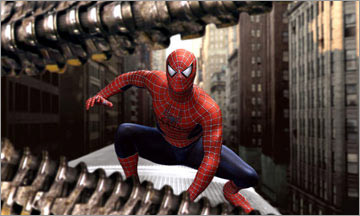 Dr. Octopus may force Peter’s hand (Peter again sees clearly, has a clarity of purpose which is symbolized by the fact that his powers have returned, allowing him to discard his glasses, which actually break when they hit the ground in a close-up shot), but he would not have saved New York (or if he did, by some chance save NYC, he would have definitely returned to his old ways) if one key event did not happen in the process: he rips off his mask while attempting to the stop the runaway subway train. Though the actual event is treated somewhat casually, being placed in the middle of an exciting action sequence, for the first time, Peter and Spider Man exist simultaneously, the first of the many time he reveals his identity in the last third of the movie. First he reveals himself to the “people,” who reverentially pass his limp, exhausted body to the back of the train (the way Raimi frames the overhead shot, with Maguire’s arms extended, it reminded me of a Christ pose), marvel at the fact that this folk hero is really just like them (as one man says, “he just a kid, no older than my son,”), and then embodying Aunt May’s definition of heroism, rally around Spider Man to protect him from Dr. Octopus, even though they have no chance of really stopping him. The second revelation is to Harry, who is so shocked by what he learns, he can barely process what is going on, and slides into madness (I actually thought these scenes were rushed, but they clearly are setting up the next sequel in these sequences).
The third and fourth revelation come in quick succession. After defeating Dr. Octopus, the unmasked Peter is able to appeal to the good person still inside him, acting as a catalyst that allows Dr. Octavius to reassert mental control over the A.I. tentacles. Now, like Peter, in control of his powers, Dr. Octavius makes a bid for redemption, choosing “not to die like a monster,” and instead saves NYC from the runaway fusion reaction that he initiated. The fourth revelation is inadvertent, as well as most important, and involves, of course, Mary Jane, who after a sudden cut, stands beaming (quite literally, the way they light up Kirsten Dunst’s face) at the realization that not only is Peter not a unreliable disappointment, but that he really does love her. Suddenly, everything makes sense (her suspicions from the first film are ultimately confirmed as she states “...I think I’ve always known”).
Even so, the integration of Peter and Spider Man is not complete, and despite her protests, he returns her to her fiancee so she can safely lead a normal life (though at this point, I was thinking, “geesh, Peter, she’s not too safe anyways”). However, this final revelation gives rise to the final, most important choice of the many made by the characters over the course of the film (Aunt May chooses to move on with her life; Harry chooses to give in to vengeance; Peter chooses to become Spider Man again; while Dr. Octavius chooses to save New York City), Mary Jane rejects Peter’s one-sided decision, and chooses to be with him, running out of her own wedding, and meeting Peter, who was sitting alone, in his dark, hovel-like apartment. Mary Jane’s love and willingness to sacrifice a “normal” life to be with him, removes the one last psychic barrier that stands between the full integration of Peter and Spider Man (guilt and self-sacrifice have their limits). With a hoop and a holler, he leaps from his apartment window to save the day.
Part II - Odds & Ends
So I decided to divide this post into two parts, because some of things I wanted to bring up couldn’t be shoehorned into my interpretation of the film as I wrote it. So I just wanted to touch on a few subjects:
Comedy - The first film had some comedic parts, especially the scene-stealing antics of JK Simmons as the brash JJ Jameson, chief editor of The Daily Bugle. He returns, and yes, again Simmons steals every scene he is in, though in the sequel, his part has been expanded to include scenes set outside the office, though he thankfully never loses that gruff Front Page-esque edge (he also has to compete with another scene-stealer, Bruce Campbell, who plays the anal usher at Mary Jane’s play). However, Spider Man 2 is a lot funnier than its predecessor, relying on more absurd sight gags and goofy slapstick humor (my favorites being Peter’s battle against the broom closet; Spider Man’s ride down the elevator and revelations about his costume; and the car alarm), which serves to lighten what is in reality a fairly dark story. Not that I think I could ever stomach a completely serious comic book film, such as, say The Hulk.
Horror - I personally thought that the film struck fertile new ground by allowing Raimi to return to his roots and emphasize some of the horror aspects inherent in the film. The entire scene where Dr. Octopus awakens in the OR is stylistically taken from the anarchic Evil Dead mold, while the A.I. tentacles themselves are so threateningly bio-mechanical that Cronenberg would be proud. Then there was the foreboding vibrations and rumbling that preceded Dr. Octopus’s arrival, which was something straight out of a monster movie. Good stuff.
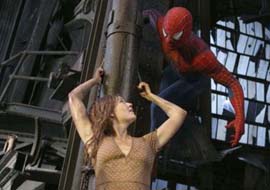 Action/SFX Action/SFX - One of the things I enjoyed the most from the first film was the sheer exhilaration of watching movement on the screen (its an underappreciated value). This time, while there were was more of the same, my visceral reaction was not as great. However, I thought that the special effects were a vast improvement over the original film, which I referred to as an “animated film” (and I did not really mean that as a slam against the film) because I was always cognizant of the digital avatar moving across the screen. Though I still was always aware of the fact that the Spider Man figure was always a digital creation, I thought the filmmakers did a much better job of making Spider Man appear more natural in terms of matting, modeling the light around the body, color contrast (Spider Man was not as bright red and blue as he was in the first film), and more naturalistic-seeming movement. They may have wanted to put more work into the visual quality of Dr. Octopus since it varied from scene to scene.
Now onto the action. While on the whole, I think that Spider Man 2 actually had less action than the first film (its a very talky film), I can’t think of anything in the first film which would match the train-fight sequence of the sequel (the scene where Spider Man has to choose between saving Mary Jane or the tram full of people comes really close), which I thought was brilliant, fast-paced, and exiting from start to finish. I personally loved the fact that the engineers were needling Parker as he was trying to save them. I thought it added a little human touch to the entire superhuman proceedings.
One last note, can someone please, pretty please, hire someone else than Danny Elfman to score a superhero film. I’m really getting sick of the same musical motifs in film after film.
A Matter of Life and Death
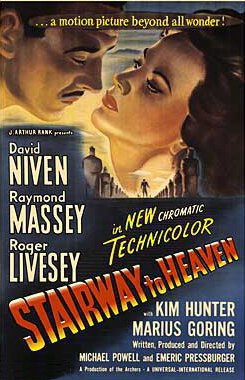 A Matter of Life and Death A Matter of Life and Death, aka Stairway to Heaven, 1946 (directed by Michael Powell and Emeric Pressburger; starring David Niven, Kim Hunter and Roger Livesley).
I'm fascinated by movies that offer interpretations of heaven and life after death. I'm not sure why the subject matter interests me so much; I guess because no one really knows what happens after we die, so there's no right or wrong answer, just endless speculation and lots of room for imagination.
Powell & Pressburger's A Matter of Life and Death is similar in theme to Here Comes Mr. Jordan (later remade as Heaven Can Wait and Down to Earth) -– due to a Heavenly administrative error, a mortal finds himself in limbo and bargaining with the Powers That Be to reclaim his life on earth.
The opening scenes of A Matter of Life and Death find squadron leader Peter Carter (David Niven) about to bail out of his burning aircraft. He radios back to base and reaches an American WAC, June (Kim Hunter), to report his location. He tells her he's bailing out, but he has no parachute. In what he believes to be his last few moments on earth, he makes a last desperate and rather poignant connection with June, who represents the life that he's leaving behind. June is devastated when he signs off and jumps, knowing his chances for survival are zero.
So it's a surprise to everyone when he washes up on shore in a heavy fog, quite alive and unharmed, save for a little scratch on his head. When he finds June through the Movie Magic of Unbelieveable Coincidence (or perhaps it's just destiny), it's inevitable that they fall in love.
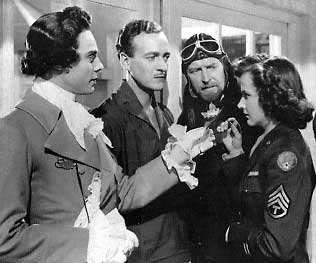 Meanwhile, up in heaven, Carter's flying buddy Bob Trapshaw has been waiting for him, but he hasn't shown up yet. It turns out that Peter's Conductor, a foppish, erstwhile French aristocrat who was executed during the French Revolution (Marius Goring), simply missed Carter in the fog and failed to collect his soul. By the time his error is discovered, Peter has met June already and fallen in love. The Conductor returns to earth to bring Peter to heaven, but Peter refuses, asking for an appeal to the higher court.
His appeal is granted, but the prosecutor assigned to his case is Abraham Farlan (Raymond Massey), a Bostonian who was killed by a British bullet in the American Revolution, who still holds a grudge against the English and is none too pleased about Carter's dalliance with a nice American girl. Carter will have his work cut out for him to convince Farlan that he deserves another chance at life.
It's about at this point that the movie gets bogged down briefly in criticism of Great Britain's imperialist history and an antiquated rivalry between the US and England that seems a little forced. I've read that A Matter of Life and Death was meant to foster post-war relations between England and the United States, casting Peter and June as the star-crossed lovers designed to bring the Hatfield-and-McCoy-like feud to an end. Unfortunately, it slows down the narrative, and because it's introduced so late in the film it feels out of place and disorienting.
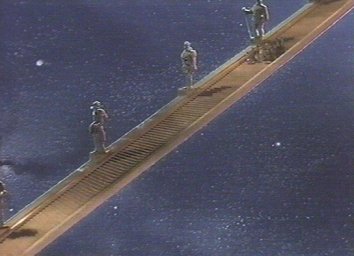 A Matter of Life and Death A Matter of Life and Death is a lush romantic fantasy written and directed by the famed team of Michael Powell and Emeric Pressburger ( The Red Shoes, The Life and Death of Colonel Blimp, Black Narcissus). The sequences that take place on earth are shot in glorious Technicolor, while the heaven scenes take place in black & white –- the opposite of what I was expecting. The black & white photography turns heaven into a cold and clinical place, which is run by clerks and paper pushers. The camera work (by Jack Cardiff) and special effects are great, making heaven seem impossibly huge and densely populated.
Kim Hunter does a good job in an underdeveloped role as June. She has little to do but gaze lovingly and sob silently and sacrifice heroically, but her headlong and constantly-in-jeopardy romance with Niven is completely believeable. She takes a small role and makes it memorable.
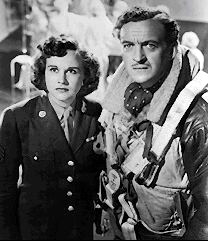 David Niven, a highly underrated actor with all the comic timing of Cary Grant, lends a humanism to Peter Carter, a role that easily could have been bogged down in overwrought selfless nobility in the hands of a lesser performer. In fact, the whole movie could easily have collapsed under the weight of the saccharine theme of love-conquers-death, as many others have ( Ghost comes to mind). And somehow, even though the afterlife is portrayed as a stark bureaucratic place, it doesn't seem like a bad place to go when it's all over. Clearly, though, the emphasis in this post-war world is a celebration of life, in living color.
Not available on DVD in the U.S. yet, but a region 2 disc is available if you have an all-region player. The VHS is out of print, but well worth seeking out.
|

